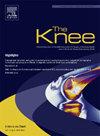经皮等长重建内侧副韧带和后斜韧带的效果与开放技术相似,中期随访时并发症发生率降低:一项回顾性比较研究
IF 1.6
4区 医学
Q3 ORTHOPEDICS
引用次数: 0
摘要
背景涉及浅内侧副韧带(sMCL)和后斜韧带(POL)的膝关节损伤可导致严重的不稳定性。开放手术技术的切口较大。经皮技术可提供类似的效果,同时降低发病率并缩短恢复时间。本研究的目的是比较使用等距异体移植的经皮重建和开放重建的临床和功能效果。方法对2010年至2021年间的21例患者进行了回顾性比较分析。11名患者接受了开放手术,10名患者接受了经皮手术。对主观的 IKDC、Lysholm 和 Tegner 评分以及外翻松弛度进行了评估。结果 两组患者术后的功能评分均有显著改善,外翻松弛程度也有所减轻,无明显差异。IKDC 评分平均提高了 32.3 分,Lysholm 评分平均提高了 37.9 分。Tegner 评分平均降低了 1.1 分。所有患者术后内侧关节开口的影像学测量值均为 2 毫米。经皮手术组的并发症较少,关节纤维化的发生率明显较低(开放手术组为 0 例,经皮手术组为 4 例)。结论采用等长技术经皮重建膝关节内侧是一种安全有效的手术,其效果与开放重建相似。经皮重建的优点包括切口更小、疼痛和疤痕更少、恢复时间更短、并发症风险更低。与自体移植物相比,异体移植物更受青睐,可避免供体部位发病和内侧稳定器受损。本文章由计算机程序翻译,如有差异,请以英文原文为准。
Percutaneous isometric reconstruction of medial collateral and posterior oblique ligaments offers similar outcomes to open techniques with reduced complication rates at a medium-term follow-up: A retrospective comparative study
Background
Knee Injuries involving the superficial medial collateral ligament (sMCL) and posterior oblique ligament (POL) can cause severe instability. The open surgical technique involves larger incisions. A percutaneous technique may offer similar outcomes with reduced morbidity and a shorter recovery time. The purpose of this study was to compare the clinical and functional outcomes of percutaneous and open reconstruction using isometric allografts.
Methods
A retrospective comparative analysis was conducted on 21 patients between 2010 and 2021. Eleven patients underwent open surgery, while 10 underwent percutaneous surgery. The subjective IKDC, Lysholm, and Tegner scores, and valgus laxity were evaluated. Complications were also recorded.
Results
Both the groups demonstrated significant improvements in functional scores and a reduction in valgus laxity postoperatively, with no significant differences. The mean improvements were 32.3 for the IKDC score and 37.9 for the Lysholm score. The average reduction in the Tegner score was 1.1 points. Postoperative radiographic measurements of medial joint opening were < 2 mm in all patients. The percutaneous group had fewer complications, with arthrofibrosis being significantly less frequent (0 vs. 4 in the open group). The mean follow-up was 3.5 years.
Conclusion
Percutaneous reconstruction of the medial side of the knee with an isometric technique is a safe and effective procedure that provides results similar to those of open reconstruction. The advantages of percutaneous reconstruction include smaller incisions, less pain and scarring, shorter recovery time, and lower risk of complications. Allografts are preferred over autografts to avoid donor site morbidity and weakening of the medial stabilizers.
求助全文
通过发布文献求助,成功后即可免费获取论文全文。
去求助
来源期刊

Knee
医学-外科
CiteScore
3.80
自引率
5.30%
发文量
171
审稿时长
6 months
期刊介绍:
The Knee is an international journal publishing studies on the clinical treatment and fundamental biomechanical characteristics of this joint. The aim of the journal is to provide a vehicle relevant to surgeons, biomedical engineers, imaging specialists, materials scientists, rehabilitation personnel and all those with an interest in the knee.
The topics covered include, but are not limited to:
• Anatomy, physiology, morphology and biochemistry;
• Biomechanical studies;
• Advances in the development of prosthetic, orthotic and augmentation devices;
• Imaging and diagnostic techniques;
• Pathology;
• Trauma;
• Surgery;
• Rehabilitation.
 求助内容:
求助内容: 应助结果提醒方式:
应助结果提醒方式:


